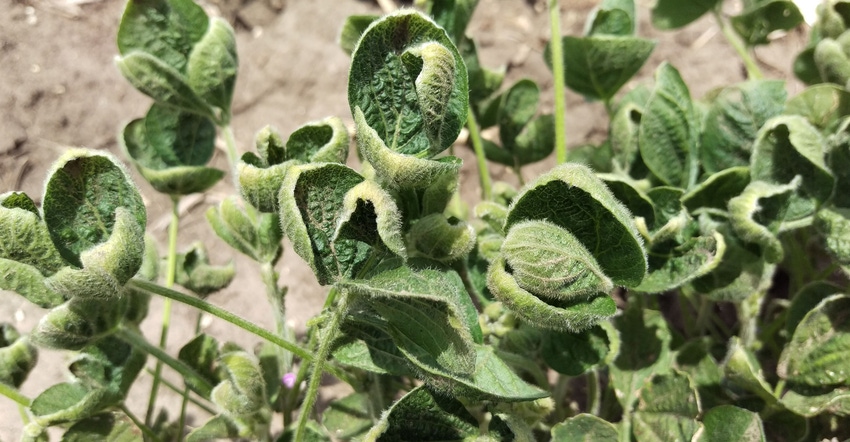
While not as widespread as in states to the southeast, Nebraska has seen its share of off-target dicamba injury in the last couple years. While total complaints this year declined compared to last year, estimates range from 25,000 to 50,000 acres of soybeans showing signs of dicamba injury — mostly in southeast through south-central Nebraska. Those estimates are only from the number of acres reported.
Unlike last year, there have been more complaints of dicamba injury on other sensitive crops, such as trees, alfalfa and grapes.
In many cases, it's difficult to say exactly where off-target movement originated. However, with the knowledge that after V1, a new trifoliolate-bearing main stem node appears on the soybean plant's main stem every 3.7 days until the plant reaches R5, researchers can count the number of main stem nodes on dicamba-injured plants to determine approximately when the damage occurred.
Growers can use the forensic method themselves to determine roughly when dicamba injury occurred. First, count number of nodes from the cotyledon (0) and unifoliolate (1) up to the last fully developed leaflets. Take this number times 3.7, and it should give you roughly the number of days since the soybean plant emerged. This provides an approximate calendar date for emergence. Then identify the first node where the injury occurred and count the nodes to the last fully developed leaflets.
For example, if it occurred on the fifth main stem node, and there are nine main stem nodes, take the remainder, four times 3.7., and it tells us the injury occurred roughly 14 or 15 days ago (assuming you collected the plant sample today).
Using this method, Jenny Rees Nebraska Extension educator in York and Seward counties, says it's apparent some cases of injury in her part of the state originated earlier in the year — sometimes from applications on corn acres.
"At first, in my part of the state, we were getting off-target movement from corn applications around the Memorial Day timeframe. The first injuries we were seeing were from corn," she says. "It wasn't until later that we started tracing injury back to post applications on soybeans, and on a more limited basis, pastures and railroad right-of-ways around mid- to late June."
"That's the challenging part. I don't think we can pin it all on applications on soybean fields," says Todd Whitney, Extension educator in Furnas, Gosper, Harlan and Phelps counties. "We can't say it's from one source, because dicamba can move through many application forms."
In many cases this year, injury likely came from movement through volatilization, with signs of injury, such as cupped leaves, being consistent across entire fields more often than not. However, it's important to double-check to make sure tank contamination wasn't an issue that contributed to the off-target movement.
Depending on the timing of application, the impact of dicamba injury on soybean yield can vary. And the impacts go beyond yield. With cupped leaves, soybean plants don't canopy as quickly, allowing sunlight to hit the exposed soil below to be intercepted by weeds.
The challenge is with the spread of glyphosate-resistant weeds like Palmer amaranth, growers need a new chemistry and site of action to control weeds, and dicamba products have provided the control they need.
"Dicamba has worked well so far in controlling Palmer amaranth in my part of the state. So it’s applied on corn, and in a week or two, we see soybeans cupping as a result of volatilization or drift. The plants grew out of injury symptoms due to rain and irrigation. Sometimes fields received a second off-target movement due to tank contamination, volatility due to temperature inversions, or drift from applying dicamba on soybeans, which made the soybeans cup again. Plants remain cupped longer when they are non-irrigated and under drought-stress," Rees says. "Some farmers have said, 'We're doing it to ourselves. We hate the fact that our soybeans don't canopy as quickly, yet we need the product for weed control in our crops.' It's a difficult situation."
Whitney adds steps also need to be taken to ensure dicamba remains effective as a control method, including rotating sites of action to prevent weeds from developing resistance.
"We do not want people to use dicamba exclusively, even though it is providing good control. It only takes four generations, or four years to develop dicamba resistance if you repeatedly expose weeds to dicamba," he says. "I think there's an acceptance that we're going to have to deal with a certain degree of injury, and we need to take a community-wide approach to mitigating injury, but we still have a way to go."
About the Author(s)
You May Also Like






